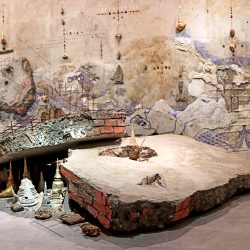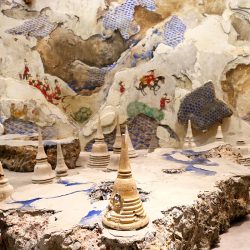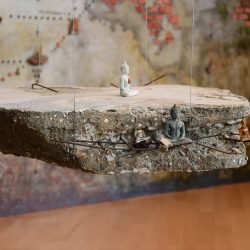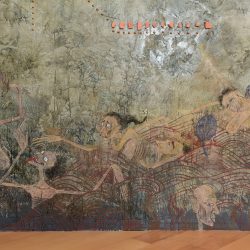WINNING THE 11TH BENESSE PRIZE MAKES HER THE SECOND THAI ARTIST TO BE GIVEN THE AWARD AFTER RIRKRIT TIRAVANIJA
Pannaphan Yodmanee’s first art lesson took place at Wat Ka Pied Temple located next to her home in Nakhon Si Thammarat province. She started off with traditional Thai art, painting and restoring mural art on the walls of the Buddhist temple. Her skills improved as she began to do small jobs outside of the temple, painting signs for local events, from ordination ceremonies to funerals. She submitted her work to compete for TOSHIBA’s art awards when she was in junior high, just before she pursued her studies at the College of Fine Arts of Nakhon Si Thammarat with the hopes of being accepted into Silpakorn University in Bangkok. The most recent update in her rising success is her naming as the winner of the 11th Benesse Prize, making her the second Thai artist to be given the award after Rirkrit Tiravanija won in 2003.
“I left Thai art behind for three years. At Silpakorn, I was able to learn about installation, performance, films, and at the end of the day, in my mind, there is nowhere else to go but back to who I am,” Yodmanee told art4d about her return to Thai art when she was in her junior year. Most of her works at the time were painting on canvas. She first used a concrete slab as a substitution for canvas for her thesis project in the Faculty of Painting, Sculpture and Graphic Arts and the first of the two reasons behind the shift, according to her own explanation, is how the material has always been imprinted in her memory from when she was just a kid, painting on the temple’s walls. The next reason happened as a coincidence after Yodmanee saw her father fixing the cracks on the house’s floor using epoxy that was left over from the silver making process (her family’s business), creating a shiny effect on the concrete’s texture. “I thought that it could be used as a material for my work. I hired a concrete finisher to do the concrete casting but it ended up being way too heavy to use.”
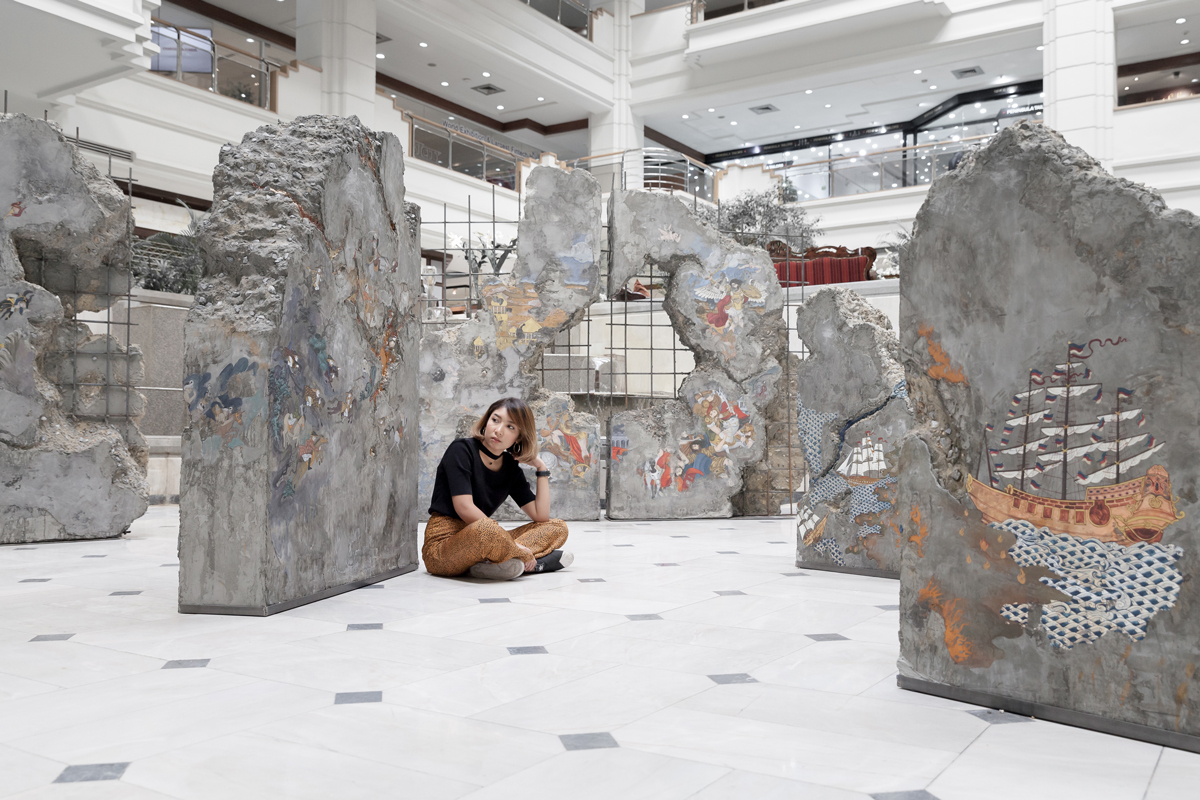
She decided to demolish the cast concrete wall and attempted to construct a new one by herself. The slab was made thinner and lighter to be able to fit it in a frame. Yodmanee became interested in a pile of concrete slabs left behind the faculty’s building. “A friend told me that if I won a prize using this pile of junk, she wouldn’t compete in any competition ever again. I was really hurt to hear that but the work ended up winning an award, and my friend stopped competing for awards following (laugh).” Prophecy (2014), the concrete installation was hung from the ceiling of the Bangkok Art and Culture Centre and Saatchi Gallery where the Thailand Eye exhibition (2015-2016) was hosted. The work was later developed into an installation of a larger scale titled The Prophecy of Time (2015), when it was exhibited at 2015’s Art Stage Singapore.
“The idea for The Prophecy is derived from Picture Books of the Three Worlds. I question the stories in that book and whether they are true or just a myth by recreating it. And as the creator of the book, I imagine what kind of stories I would tell and what kind of paintings I would put in.” Questioning the status of the book as a historical object is carried out by reversing the concept of the painting in the original book, which revolves around the documentation of the past to predict the future. In other words, ‘The Prophecy’ is a newer version of the Picture Books of the Three Worlds where a more contemporary story of prognostication is recreated using the visuals and aesthetics of traditional Thai art painting (which is also a signification of the past).
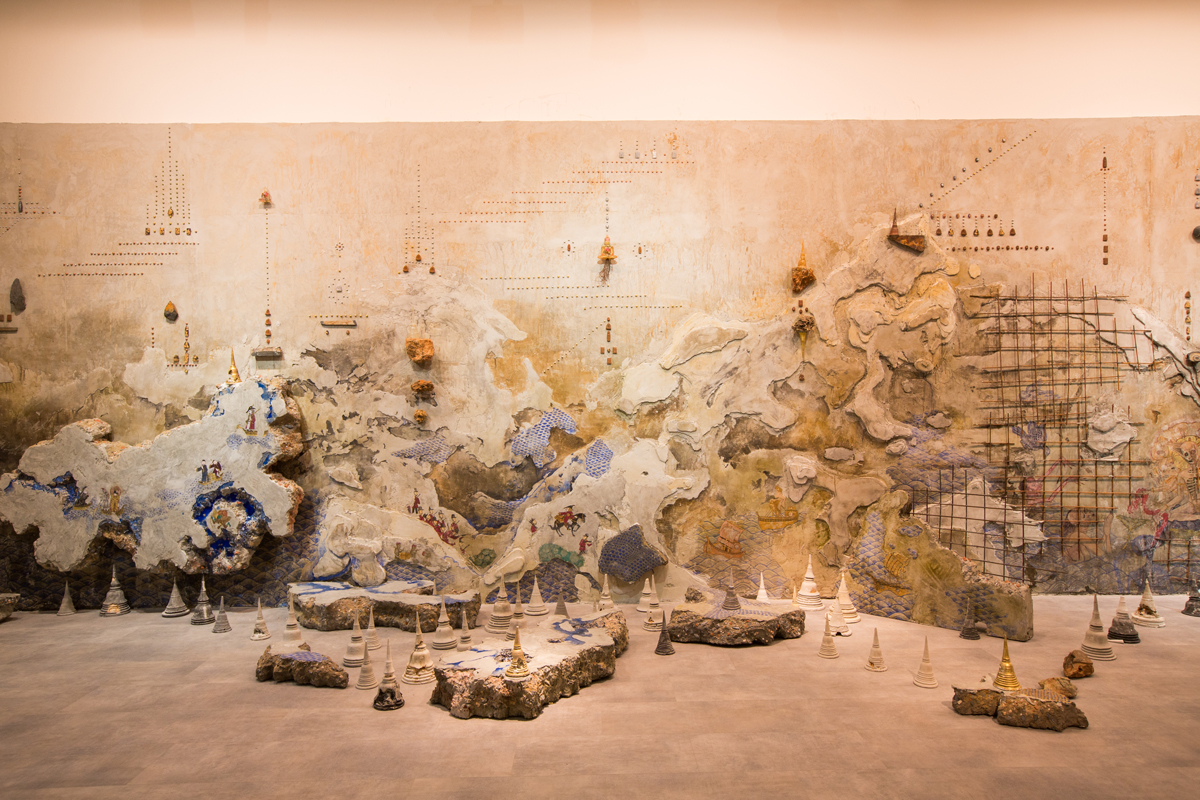
The overall atmosphere of ‘Aftermath (2016),’ exhibited in the Singapore Biennale 2016
The artist continues to develop religion as a concept in Aftermath (2016), a work that won Yodmanee the Benesse Prize last year. Generally speaking, the overall appearance of Aftermath looks pretty much like a deteriorating piece of concrete (the artist told art4d that in order to keep the work from being too heavy, foam concrete was used as her choice of material). The work’s physical form and concept bears a distinct connection with Yodmanee’s previous work. Aftermath conveys a circulation of cultures in the Southeast Asian region propelled by proselytism and the effects that have been caused by such phenomenon. “I compare it to the current situations and conflicts that are happening in the region, from the Rohingya refugee crisis to religious wars and so on and the fact that these things don’t just happen in this time period but have taken place repetitively throughout the past and it is humans who use religion as a tool to discriminate against and destroy each other.” The effect that Yodmanee speaks about through Aftermath also includes certain ‘traces’ left behind in all of us. “Hundreds of years after our war with Burma, we Thais have been taught that they were the villains, and what is going on today is the aftermath of the incident that is left behind in the form of a (written) history.”
One of the most interesting issues that has been presented and discussed in many of Yodmanee’s works is the shifting of context. The result goes beyond the contemporary approach to the aesthetics of traditional Thai painting, which has become the distinctive characteristic of Yodmanee’s artistic repertoire, to the more profound aspect of transforming a moral painting (whose original role is to ‘educate’) into a contemporary work of art. The next question art4d asked Yodmanee was when a moral painting is put in the context of Contemporary art, can it still educate?, which she answered straightforwardly. “It can but the difference is that in the past these paintings served only the upper class, but today they are being used to communicate with everyone. For instance, if we were to discuss the essence of a religion using a Buddhist statue with one half revealing the skeleton under the beautifully polished surface, what this means is that the very core of Buddhism is not made up of a beautiful form and the Buddha is just a human being with actual flesh and blood. I know I cannot tell anybody what to think. What my works do is they try to communicate with the viewers while not propagating religious belief.”
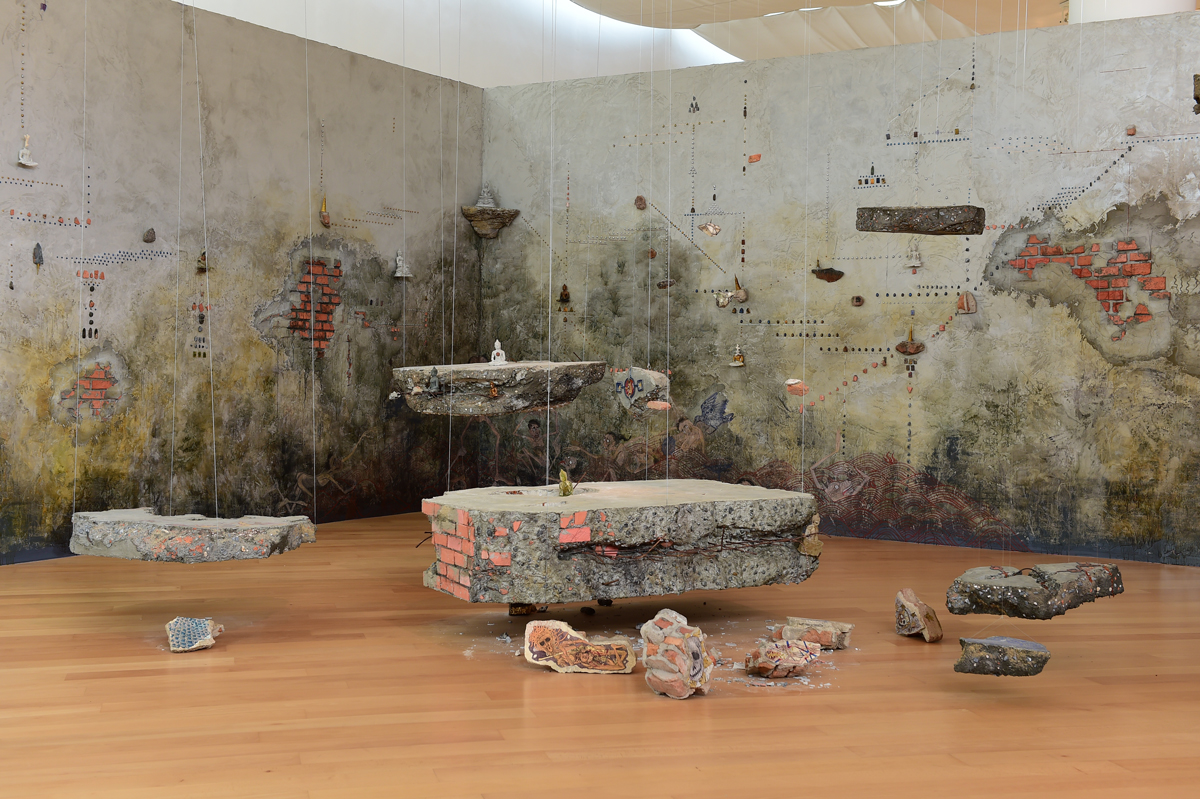
‘Prophecy (2014),’ exhibited in the Thailand Eye Exhibition (2016) held at the BACC
Yodmanee recently held a solo exhibition titled ‘RUIN’ at 1PROJECTS in which she shared another development of Aftermath. The work talks about the fallouts of religious wars, as well as those who have been the victims of war, from women and kids to soldiers who are, in a way, the victim of abusive uses of power. Her use of found objects has become more noticeable these days and the artist described to art4d that she has a current obsession with war, which drives her to scout out old objects to use within her artistic creations. With ‘RUIN,’ brought to the gallery’s space is an installation made up of combat helmets, a steel structure of an army bed and military cases used for carrying weapons. Winning the 11th Benesse Prize at Singapore grants her a chance to work at Benesse Art Site Naoshima, which is considered to be a big leap in her career as an artist. While Yodmanee still can’t tell us exactly what her new work is going to be like, we might get to witness a wonderful display of colorful traditional Thai paintings on the walls of a cave on a Japanese island very soon.
โรงเรียนสอนศิลปะแห่งแรกที่ปานพรรณ ยอดมณี เข้าไปศึกษาคือ วัดกระเปียด จังหวัดนครศรีธรรมราช ที่ตั้งอยู่ข้างบ้าน เธอเริ่มต้นเรียนจากศิลปะไทยประเพณี อย่างภาพเขียนฝาผนังในพุทธศาสนา ก่อนจะเริ่มออกมาทำงานนอกวัด รับจ้างเขียนป้ายตามงานต่างๆ ทั้ง งานบุญ งานศพ ส่งภาพเขียนสีเข้าประกวด TOSHIBA ตอนมัธยมต้น เข้าศึกษาที่วิทยาลัยช่างศิลป นครศรีธรรมราช เพื่อกรุยทางให้ตัวเองเข้าเรียนที่มหาวิทยาลัยศิลปากรในกรุงเทพฯ จนล่าสุด ปานพรรณกลายมาเป็นคนไทยคนที่สองที่ได้รับรางวัลสูงสุดของรายการ Benesse Prize ต่อจากฤกษ์ฤทธิ์ ตีระวนิช
“เราทิ้งศิลปะไทยไปสามปี ตอนมาถึงที่ศิลปากร เราได้เรียนอินสตอลเลชั่น เพอฟอร์มแมนซ์ ภาพยนตร์ จนสุดท้าย ในความคิดของเรา เราคิดว่ามันสุดจนไม่รู้จะไปทางไหนต่อแล้ว ก็เลยกลับมายังตัวตนของเรา” ปานพรรณ บอกกับ art4d ว่าเธอเริ่มกลับมาทำงานศิลปะไทยตอนเรียนอยู่ปี 3 ตอนนั้นผลงานของเธอยังคงเป็นภาพเพ้นท์ติ้งบนผืนผ้าใบ ผลงานแรกที่เริ่มเธอเริ่มเปลี่ยนมาใช้แผ่นปูนเป็นพื้นผิวคือวิทยานิพนธ์ที่คณะจิตรกรรมประติมากรรมและภาพพิมพ์ ส่วนสาเหตุที่เธอเปลี่ยนพื้นผิวผลงานมาเป็นปูนนั้นมาจากสองสาเหตุ หนึ่งคือภาพเก่าที่ติดตามาตั้งแต่เด็กอย่างภาพเขียนบนฝาผนังวัด และสองคือความบังเอิญที่เธอเผอิญไปเห็นพ่อซ่อมรอยแตกบนพื้นปูนขัดในบ้านด้วยการเทอีพ็อกซี่ที่เหลือจากการทำเครื่องเงินลงไปถมรอยแตก (บ้านของเธอเคยประกอบกิจการเครื่องเงิน) ซึ่งทำให้เกิดเอฟเฟ็คต์ความแวววาวที่น่าสนใจบนพื้นผิว “เราคิดว่ามันน่าจะเอามาทำงานได้ ตอนนั้นเลยจ้างช่างปูนให้มาหล่อปูน แต่ผลที่ได้ก็คือมันหนักเกินไปที่จะเอามาทำงาน”
ปานพรรณตัดใจทุบผนังปูนทิ้ง และพยายามทำขึ้นมาใหม่ด้วยตัวเองให้บางและเบาลง พอที่จะนำมาใส่กรอบไม้เป็นชิ้นงาน หลังจากงานนั้นเองเธอจึงเริ่มกลับไปมองแผ่นปูนที่กองทิ้งไว้หลังคณะจิตรกรรมฯ “ตอนนั้นมีเพื่อนบอกว่า ถ้าเราเอาขยะมาทำงานแล้วได้รางวัล จะไม่ส่งประกวดอีกเลย ตอนได้ยินเราเสียใจมาก แต่สุดท้ายงานก็ได้รางวัล และเพื่อนคนนั้นก็ไม่ส่งงานประกวดอีกเลย (หัวเราะ)” นี่เป็นหนึ่งในที่มาของ Prophercy (2014) อินสตอลเลชั่นปูนที่ถูกห้อยลงจากเพดานในนิทรรศการ Thailand Eye (2015-2016) ที่ Saatchi Gallery และหอศิลปวัฒนธรรมแห่งกรุงเทพมหานคร โดยผลงานชิ้นนี้ยังถูกต่อยอดมาเป็นอินสตอลเลชั่นในสเกลที่ใหญ่ขึ้นมาคือ The Prophecy of Time, 2015 ใน Art Stage Singapore, 2015 ที่จัดขึ้นในปีเดียวกันที่ประเทศสิงคโปร์
“The Prophecy มาจากสมุดภาพไตรภูมิ เราตั้งคำถามกับเนื้อหาในนั้นว่ามันจริงหรือเป็นแค่นิทาน ด้วยการเอามันกลับมาทำใหม่ ลองแทนตัวเองเป็นคนวาดสมุดภาพไตรภูมิดูว่าถ้าเราเป็นคนวาดสมุดไตรภูมิ เราจะใส่อะไรลงไปบ้าง?” การตั้งคำถามถึงสถานะการเป็น “ประวัติศาสตร์” ของไตรภูมิทำด้วยการพลิกกลับไอเดียของการวาดภาพไตรภูมิที่ว่าด้วยการบันทึกอดีตมาเป็นการทำนายอนาคต หรือพูดอีกแบบก็คือ ‘The Prophecy’ เป็นไตรภูมิเวอร์ชั่นร่วมสมัยที่หันมาพูดเรื่องอนาคต โดยนำสไตล์การวาดภาพแบบไทยประเพณี (ที่ก็เป็นอดีต) มาทำให้ใหม่กว่าเดิมด้วยการสอดแทรกภาพเขียนที่มีเนื้อหาร่วมสมัย
แนวคิดเกี่ยวกับศาสนายังถูกต่อยอดมายัง Aftermath, 2016 ที่เพิ่งได้รับรางวัล Benesse Prize ไปเมื่อปีที่ผ่านมา โดยรวมแล้ว รูปร่างหน้าตาของ Aftermah ที่ยังคงเป็นปูนพังๆ (ปานพรรณบอกกับ art4d ว่าเพื่อไม่ให้ชิ้นงานหนักเกินไป เธอจึงเลือกใช้ปูนโฟมที่มีน้ำหนักเบากว่า) ทำให้เห็นความเชื่อมโยงกับงานชิ้นก่อนได้อย่างชัดเจน ทั้งรูปร่างหน้าตาและเนื้อหาผลงาน Aftermath พูดถึงการหมุนเวียนแลกเปลี่ยนวัฒนธรรมในภูมิภาคเอเชียตะวันออกเฉียงใต้ ที่หลักๆ แล้วเกิดขึ้นจากการเผยแพร่ศาสนา และผลกระทบที่เกิดขึ้นจากเดินทางของสิ่งนี้ “เราเอามาเปรียบเทียบกับเหตุการณ์ปัจจุบัน ความขัดแย้งที่เกิดขึ้นในภูมิภาคทั้งวิกฤตโรฮิงยา สงครามศาสนา ว่าสิ่งนี้มันไม่ได้เพิ่งเกิดขึ้น แต่มันเกิดซ้ำครั้งแล้วครั้งเล่า และมันเกิดขึ้นจากมนุษย์เองที่ใช้ศาสนาเป็นเครื่องมือในการแบ่งแยกและทำลายซึ่งกันและกัน” ผลกระทบที่ปานพรรณพูดผ่าน Aftermath ยังรวมถึง “ร่องรอย” บางอย่างที่หลงเหลืออยู่ในตัวเราทุกคน “หลังไทยรบกับพม่ามาหลายร้อยปี การที่เราถูกปลูกฝังให้ตั้งแต่เด็กๆ ว่าพม่าเป็นผู้ร้าย มันก็คือ Aftermath ของเหตุการณ์ครั้งนั้นที่ตกค้างอยู่ในรูปแบบของประวัติศาสตร์ (ที่ถูกเขียนขึ้น)”
ประเด็นที่น่าสนใจในงานหลายๆ ชิ้นของปานพรรณ คือการเปลี่ยนบริบท ซึ่งไม่ใช่แค่การนำไสตล์การวาดแบบไทยประเพณีมาทำงานร่วมสมัยจนเหมือนเป็นจุดขายของงาน แต่ลึกกว่านั้นคือการเปลี่ยนเอา moral painting ที่ฟังก์ชั่นเดิมคือการ ‘สั่งสอน’ มาใช้ในงานร่วมสมัย art4d ถามปานพรรณว่า “พอมัน (moral painting) มาอยู่ในงานร่วมสมัยแล้วมันยัง “สอน” อยู่ไหม” ซึ่งเธอตอบกลับมาตรงๆ ว่า “จริงๆ มันยังอยู่ ต่างตรงที่สมัยก่อนสิ่งนี้มันเคยรับใช้แต่คนชั้นสูง แต่ครั้งนี้เราเอามาสื่อสารกับคนดูทั่วไป อย่างเช่นเราพูดถึงเรื่องแก่นของศาสนาด้วย figure พระพุทธรูปที่ครึ่งซีกเปิดให้เห็นโครงกระดูก มันหมายความว่าแท้จริงแล้วแก่นของศาสนาพุทธก็ไม่ได้มีรูปทรงที่สวยงาม แต่คือคนธรรมดาที่มีเลือดเนื้อ เรารู้ดีว่าสอนใครไม่ได้ และไม่ได้ตั้งใจจะสอน มันเป็นการพูดกับคนดู ไม่ใช่การเผยแพร่ศาสนา” เธอทิ้งท้าย
ล่าสุดปานพรรณเพิ่งมีนิทรรศการเดี่ยวที่ 1PROJECTS ไป คือ RUIN ที่ต่อยอดมาจาก Aftermath อีกทีหนึ่ง งานชิ้นนี้พูดถึงผลกระทบจากสงครามศาสนา เหยื่อสงคราม ทั้งคนทั่วไป ผู้หญิง เด็ก รวมถึงตัวทหารเองที่ก็เป็นเหยื่อของการใช้อำนาจเช่นกัน ดูเหมือนว่าเธอทำงานกับ found object มากขึ้นเรื่อยๆ ปานพรรณบอกกับ art4d ว่าตอนนี้เธออินเรื่องสงครามอยู่ และเที่ยวตระเวนค้นหาของเก่าๆ มาทำงานศิลปะ ดังที่เห็นได้ใน RUIN ที่เธอใช้หมวกทหาร โครงเตียงทหาร กล่องอาวุธสงคราม มาจัดแสดงในแกลเลอรี่ การไปชนะ Benesse Prize ครั้งที่ 11 ที่สิงคโปร์ปีที่ผ่านมายังทำให้เธอได้รับโอกาสไปทำงานที่ Benesse Art Site Naoshima ซึ่งถือเป็นก้าวกระโดดในชีวิตที่สำคัญทีเดียว Aftermatch จะถูกนำไปจัดแสดงที่นั่นอีกครั้งหนึ่ง รวมถึงผลงานอีกชิ้นที่จะถูกสร้างขึ้นใหม่ที่ไซต์ ตอนนี้เธอยังบอกไม่ได้ว่าผลงานใหม่จะออกมาเป็นอะไร ไม่แน่ว่าเราอาจะได้เห็นถ้ำที่เต็มไปด้วยภาพเขียนสีแบบไทยๆ ในญี่ปุ่นเร็วๆ นี้
TEXT : NAPAT CHARITBUTRA
PORTRAIT : KETSIREE WONGWAN
PHOTO COURTESY OF THE ARTIST
fb.com/Pannaphan-yodmanee-fanpage-1395404517365381


